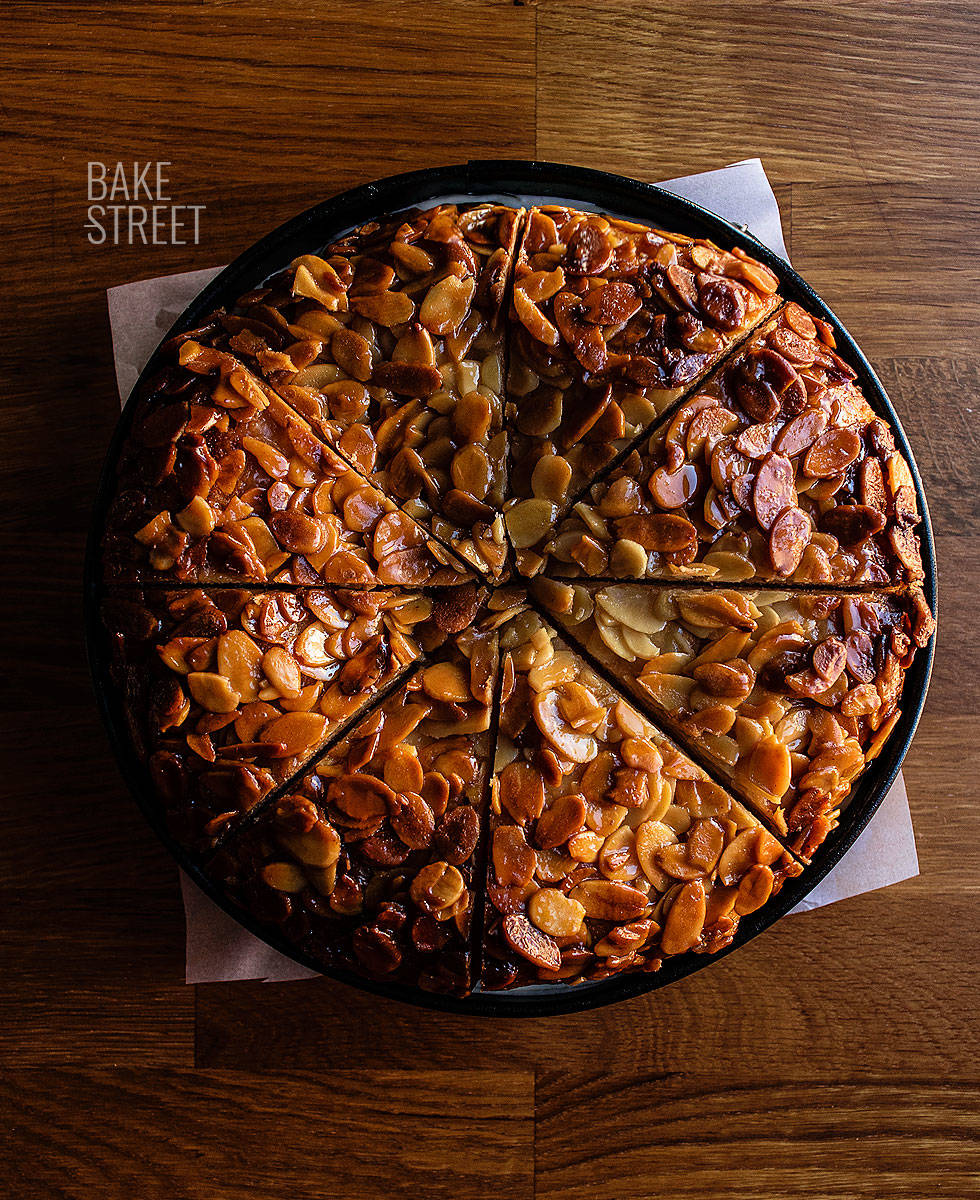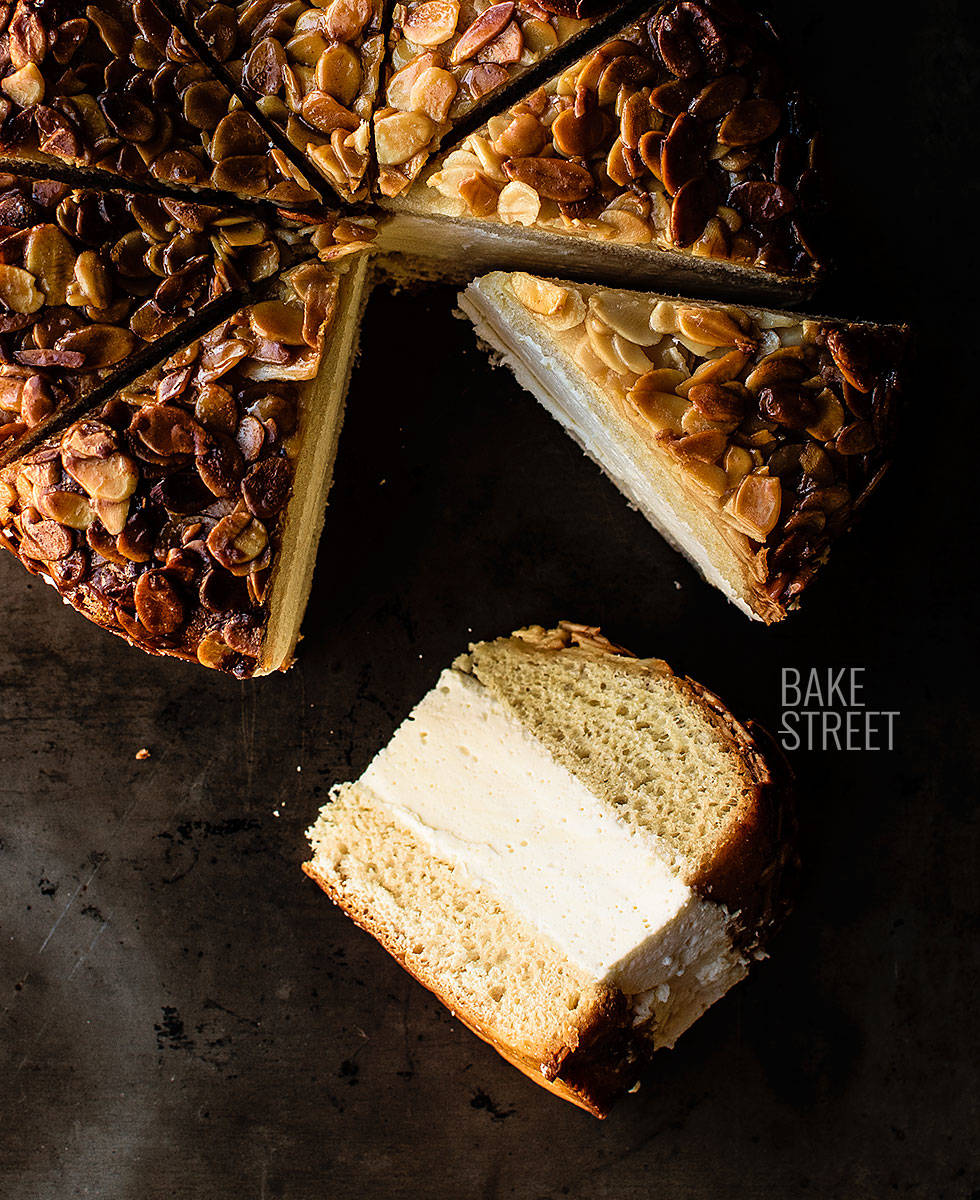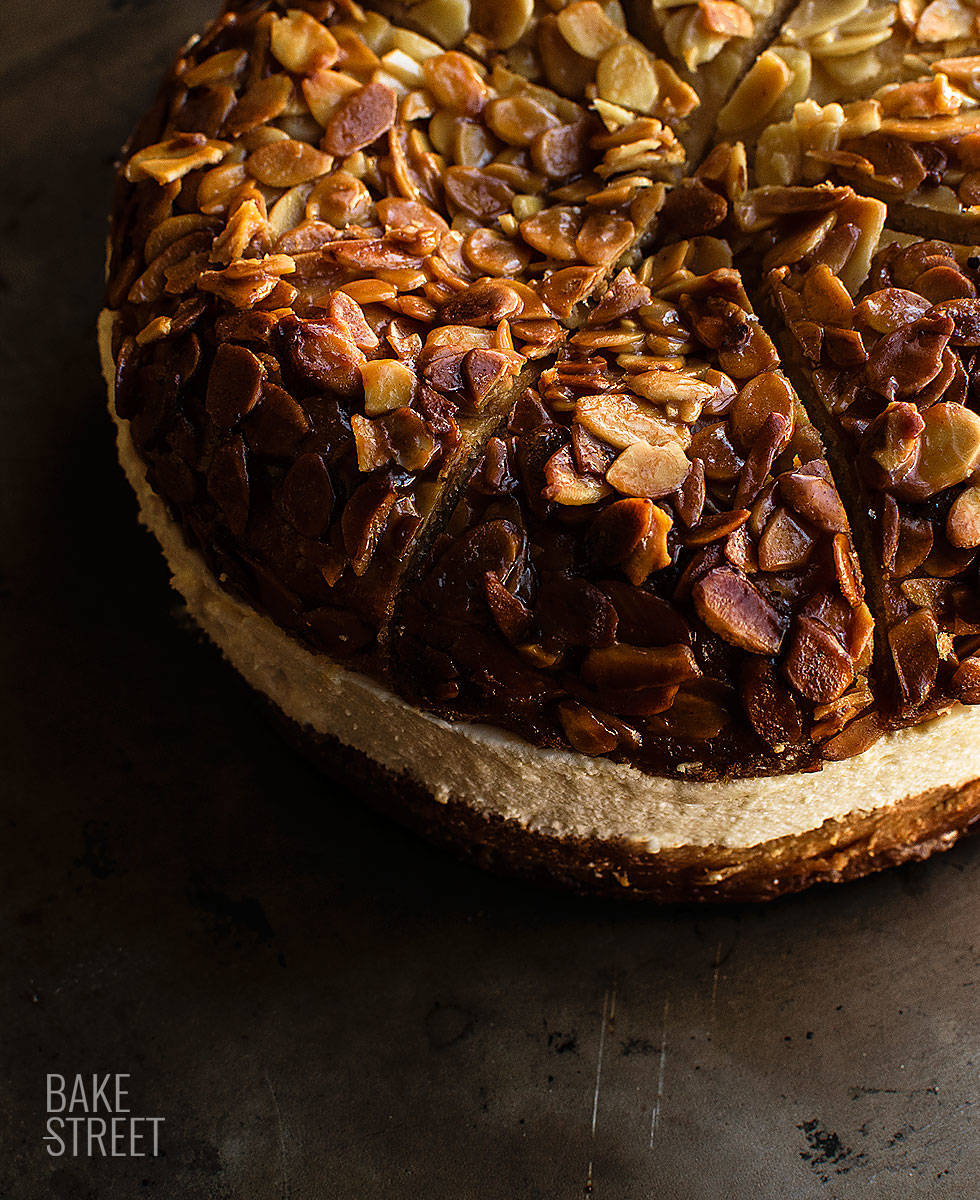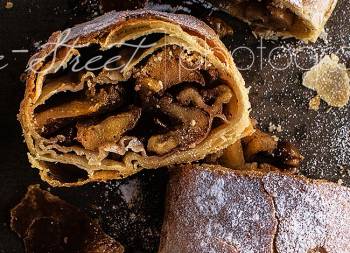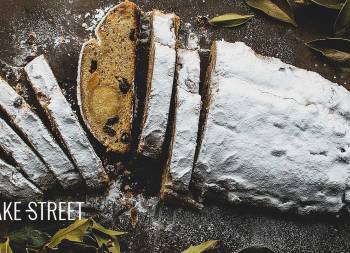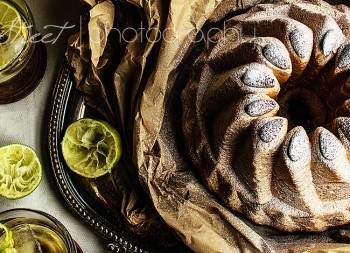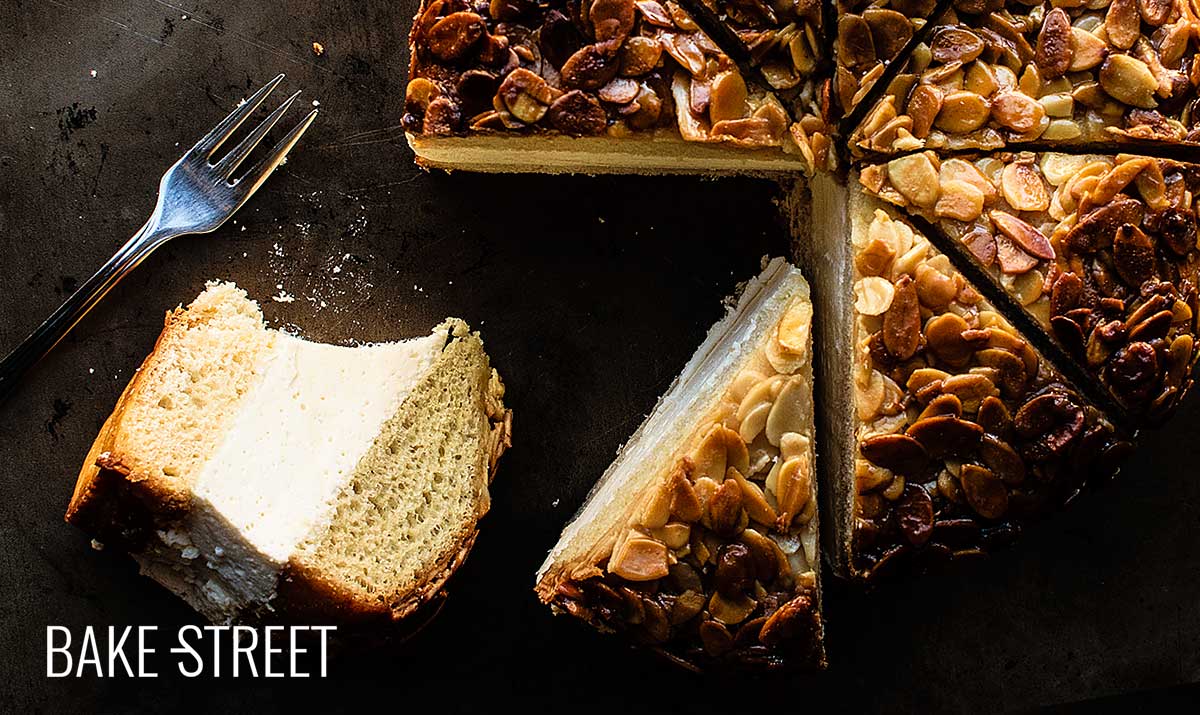
Bienenstich – Bee Sting Cake
I couldn’t tell you how long I’ve wanted to bake this cake…. You know that many times it’s not because I don’t want to, but because I don’t have the time or because at home we have sweets coming out of our ears! There are weeks when the kitchen looks like a bakery, full of cakes and buns everywhere. But, I’ve finally been able to prepare this Bienenstich or Bee sting Cake. A German pastry that, in spite of looking highly classic and traditional, is absolutely exquisite.
This cake is made with a slightly sweet and enriched dough, which we bake covered with honey, butter and almonds. Just this already, it’s very light as you can see. Then cut in half and fill with a cream made with homemade custard and whipped cream. We let it rest for one night in the cold and the next morning we die of love.

First of all I want to clarify that this is not the classic and traditional aspect of the Bienenstich.
This cake is usually made in a rectangular shape. They are usually served in pieces cut in the same format and the amount of filling is the same thickness as the dough.
As you can imagine, at home it is much easier and more convenient to make it in a round format. For that reason, most of these cakes that you find on websites and blogs, will have this shape.
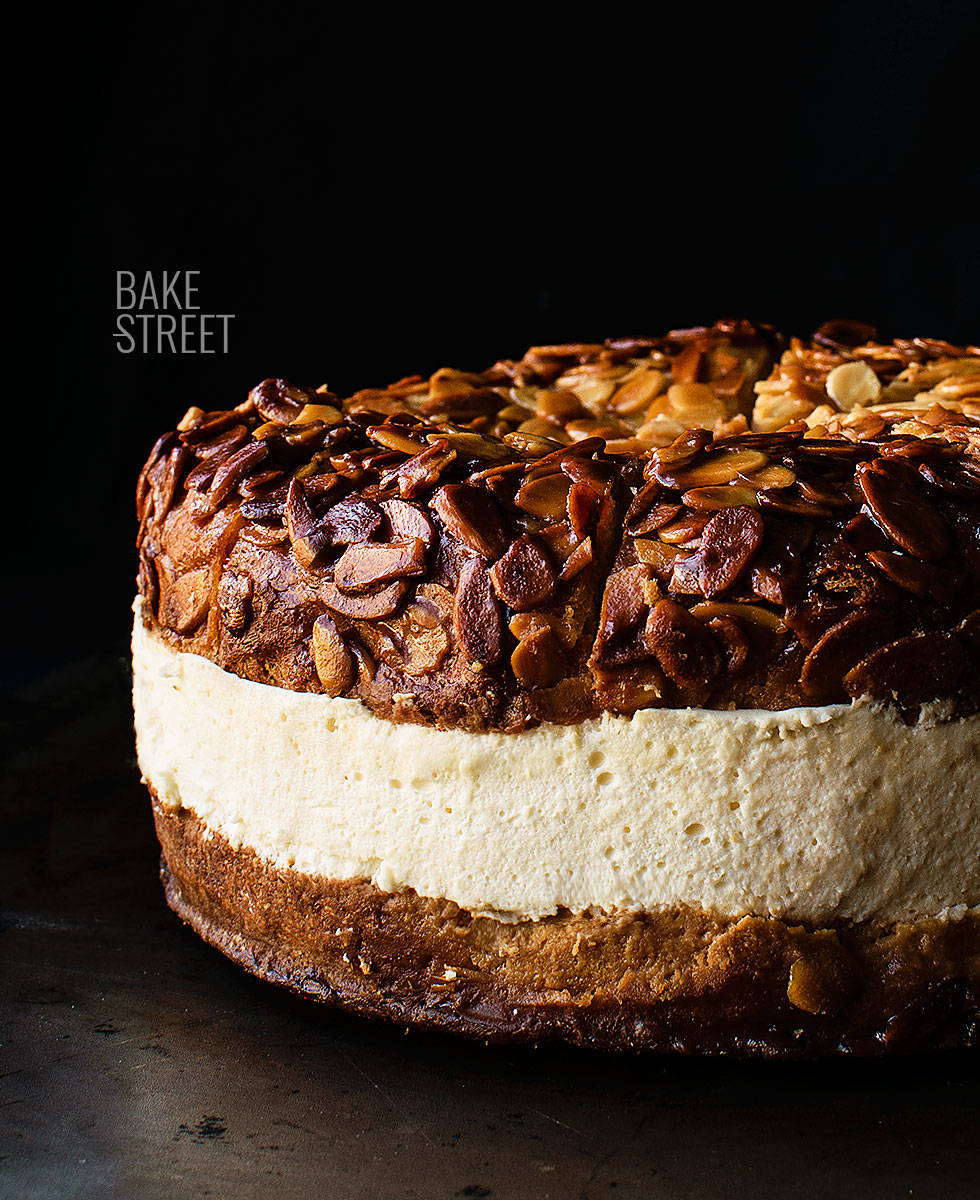
To this I must add that I wanted to make a glossy cake, overflowing, generous and why not, scandalously ordinary. I wanted it to have a lot of filling, I don’t know the reason and need to want to give it this look. Of course, as I mentioned in the notes, you can make half the filling if you don’t want it to have so much.
I adapted the recipe from the book “The Great Book of Confectionery” (this was the first pastry book my husband gave me a few years ago…), when I started with the blog!
Bienenstich origin.
Bienenstich translated from German means “bee sting“. I’m sure you’re thinking it’s a bit of a strange name for a cake. Strange or funny, depending on how you look at it.
According to legend, in 1474, the inhabitants of Linz planned an attack in the early morning against their village neighbours in Andernach. The reason was that the Kaiser had promised them the taxes of Rheim (Rim river) and therefore took them away from the inhabitants of Linz.

On the morning of the presumed attack, two baker´s apprentices were walking along the walls of the town of Andernach, eating honey from the beehives they found. When the boys spotted the inhabitants of Linz, they threw the bee nests at them and they fled in fear after being stung by them.
To celebrate, the baker from Andernach baked a cake together with the heroes who saved his village from the attack. They decided to call it a “Bee Sting Cake”.
Recipe Bienenstich - Bee Sting Cake
DOUGH:
- 8,8 oz (250 g) bread flour
- 2,1 oz (60 g) unsalted butter at room temperature
- 1 large egg
- 2,3 oz (65 g) whole milk
- 1,6 oz (45 g) sugar
- 0,14 oz (4 g) de levadura seca de panadero
- 0,17 oz (5 g) de sal
TOPPING:
- 3,5 oz (100 g) unsalted butter
- 1,6 oz (45 g) sugar
- 1,4 oz (40 g) honey
- 1 oz (30 g) cream
- 3,5 oz (100 g) sliced almond
FILLING:
- 17,6 oz (500 g) whole milk
- 3 large egg yolks
- 2,3 oz (80 g) sugar
- 2 tsp vanilla extract
- 1 Tbsp cornstarch
- 10,5 oz (300 g) cream
- 6 gelatin sheets (0,4 oz /11,25 g gelatin powder)
Instructions
FIRST DAY
Make the dough.
- Keep 2 tablespoons of milk.
- In a bowl add the flour together with the egg, milk, salt and sugar. Mix with your hands or the hook in a stand mixer to amalgamate the ingredients.
- Start to integrate the butter into the mixture and work to start mixing it. Knead after each addition so that the ingredients begin to amalgamate.
- Dissolve the yeast in the milk we had reserved and pour it to the dough. Knead again until it is completely integrated.
- Once we have added all the butter, knead until you get a good gluten development. The dough must be elastic and not cracked. It will take us about 30 - 35 minutes.
Make bulk fermentation.
- Once we have a perfect gluten development, make a ball with the dough.
- Grease a tupper or hermetic container, place the dough inside and let it rise until it doubles in size. In my case it took 6 1/2 hours at 79º F (26ºC).
Make the topping.
- Place a saucepan over medium heat.
- Add the butter and let it melt completely.
- Incorporate the sugar together with the honey and stir.
- Pour in the cream and cook over a low heat for 2-3 minutes.
- Add the almonds and mix to homogenize.
- Remove from heat and leave to cool.
Stretch the dough and make the final fermentation.
- Line the base of the mould with paper and grease the sides with butter. Sprinkle with flour and remove the excess. Set aside.
- Dump the dough on a clean, flour-free surface. Gently degas and stretch to the same diameter as our pan. Mine is 7,9 inches (20 cm) in diameter.
- Place the dough inside the pan and finish adjusting until it occupies the entire surface of the base.
- Pour the almond topping over the dough, cover with film and leave it rises until it doubles in volume. In my case, it took 2 1/2 hours at 79º F (26ºC).
Bake.
- Preheat oven to 355ºF (180ºC).
- Put it in the middle of the oven and bake for 30 minutes.Remember that the internal temperature must reach 190-195ºF (88-90ºC) for baking to be complete.
- Remove and let stand in the pan for 10 minutes.
- Remove from the pan, being very careful not to remove part of the almond coating from the ends, and let it cool completely on a rack.
- Once cooled, place in a large freezer bag and leave to stand until the next day.
SECOND DAY
Make the custard.
- In a bowl add very cold water and incorporate the gelatin. We let it hydrate for 20 minutes.
- Pour the milk into a medium saucepan with the vanilla and place over medium heat. Leave until it reaches a gentle boil.
- Remove from heat.
- In a bowl add the egg yolks along with the sugar and the cornstarch. Mix to homogenize.
- Pour some hot milk mixing with the whisk at the same time. In this way we temper the yolks and prevent them from setting into lumps.
- Return the milk to medium heat and pour the egg yolk mixture into it.
- Cook, stirring constantly, until the mixture begins to thicken. It will take about 8-10 minutes.
- Remove from heat and let the mixture reduce the temperature to 158º-149ºF (70º-65ºC).
- Add the gelatine, previously hydrated and well drained, into the mixture. Mix until they dissolve completely.
- Pour the mixture into a bowl, cover and let it cool completely.
Prepare the pan and cut the cake.
- With the help of a cake cutter, cut the sweet bread in half lengthwise. If you find almond coating on the way, it will be difficult.
- Remove the top lid and cut into 8 equal portions, set aside.
- Lined the base of the pan with baking paper, just as we did at the beginning. Set aside.
Whip the cream.
- Before make whipped cream we must know: Cream must be cold 24 hours before used it and the bowl in which we are going to make whipped cream must be cold. I recommend to use one aluminium bowl and freeze 20 minutes before whisk it.
- Pour heavy cream into freeze bowl and beat with an electric mixer into slow speed.
- Increase speed gradually but without reaches high one. Ideally use medium speed.
Add the custard.
- Pour the custard over the whipped cream and whisk again at speed 2 until smooth. Do not exceed the whipping of the cream to avoid spoiling the filling.
Finish assembling the Bienenstich.
- Place the lower part of the sweet bread inside the pan and close the ring.
- Pour the filling over the base and smooth the surface with a spatula.
- Place the top of the almond topping sweet bread over the filling.

- Refrigerate for a minimum of 5 hours but ideally let it stand overnight.
- When you unmold the Bienenstich, once you open the ring, I recommend you pass a dampened spatula around it before lifting the ring to unmold it.

Notes
- I have used a pan of 7,9 inches (20 cm) in diameter but with the quantity of ingredients of the recipe you can use up to a pan of 10,2 inches (26 cm).
- You can make the dough in 2 days if you wish, that is, by retarding it in cold during the first fermentation in the same way that I have shown you in other recipes.

- When the almond mixture is poured over the dough, it must have cooled. Otherwise, a very high temperature would speed up the rising process a lot and could damage the result.
- The amount of filling is exaggerated, I know, but I liked it that way. If you wish you can reduce the total amount by half.

- Many recipes use vanilla custard powder to make the filling. In my humble opinion, as simple as it is to do, I think it's best to make them homemade. We will know 100% the ingredients with which it is made and its taste will be much better.
- We must cut the top of the dough with the topping before placing it on the filling, otherwise we will spoil it by cutting the cake.
- We can keep the cake refrigerated in an airtight container or bell for 4-5 days.

This Bienenstich or Bee Sting Cake is an absolute wonder. A tender and fluffy dough accompanied by a soft, creamy and not very sweet vanilla cream. Yes! not too sweet. If there is one thing that German confectionery boasts of, it is not to abuse sugar in its production.
For me this has everything in its favour, as it allows you to enjoy the true essence of the product. Savor its ingredients, each and every one of them, as they will not be hidden behind tons of sugar.
However, the format has remained a first course. I'm not sure if you should have it with your coffee at the table or as a lunchtime special. In any case, you will enjoy it very much.
With this recipe I say goodbye to you for a few days.... not many!, but just to disconnect a little, recharge batteries and come back with many new recipes. Even so, I'll still be connected by social networks, so if you're encouraged by a recipe, don't forget to tag me so I can see your artwork! :D
See you after Easter! Have a good time, relax, enjoy and eat a lot and well.
Big hugs,
Eva
Sources: Springlane, Wiki.
